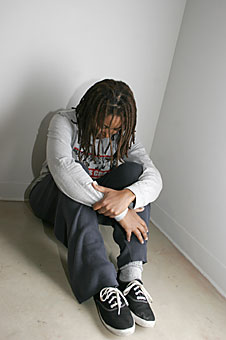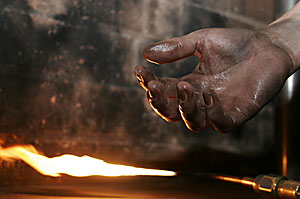 |
|
PHOTOS BY JACOB KONST/Arizona Daily Wildcat
|
A UA student reenacts the effects of sexual assault. Depression can occur following sexual abuse, which sometimes leads to suicidal thoughts and behavior.
|
|
|
By Cassie Blombaum
Arizona Daily Wildcat
Wednesday, March 9, 2005
Print this
Imagine feeling alone and hurt, unsure whether or not others will believe the pain you have experienced.
Imagine being violated for years and being too afraid to face the perpetrator, until there seems to be no option left but suicide.
According to the Bureau of Justice Statistics, studies estimate that one-third of women who are raped contemplate suicide, and 17 percent of rape victims attempt suicide.
Many victims of sexual abuse and molestation believe suicide is the only way out of such a dire situation, said Tina Tarin, a violence prevention specialist at the OASIS Program.
The OASIS Program, part of Campus Health Service, provides assistance for victims and survivors of sexual assault and relationship violence.
"Victims (and) survivors of sexual assault often contemplate suicide," Tarin said in an e-mail. "Sexual assault (or) abuse is traumatic. Any time an individual is dealing with trauma, it is a possibility to identify a correlation between the incident and any emotional or physical difficulties that develop afterwards."
Eugene Mejia, a University of Arizona Police Department spokesman, said suicide in general is a problem throughout college campuses and does affect the UA, although not as frequently.
Mejia said there does not seem to be a huge problem with suicides on campus, but every suicide is one too many.
In November of 2003, the Wildcat reported a UA student was found dead in his room in Sierra Residence Hall, 541 N. Cherry Ave.
 |
|
PHOTOS BY JACOB KONST/Arizona Daily Wildcat
|
A UA student demonstrates how victims of assault can develop self-destructive behaviors in an attempt to cope with their pain, such as cutting or burning oneself.
|
|
|
It was later discovered the cause of his death was suicide.
"In the year 2004, there (were) four attempted suicides and one successful suicide," Mejia said.
Mejia said there could also be a number of suicide attempts that go unreported.
"Unless they have other indicators that would say that this is a suicide attempt, it may not be reported," Mejia said.
Mejia said indicators of a person trying to take their life include vomiting, being sick or ingesting too many medications that may induce coma.
"Sometimes they will die," Mejia said. "Someone may mistake those types of symptoms for someone who is ill."
Mejia said although he isn't personally aware of such instances, suicide is a real possibility among those who have been sexually abused.
"Going through and trying be a survivor of sexual assault does play a large part in ones emotional condition," Mejia said. "There may be times when a sexual assault victim can't find an out to (his or her) emotional feelings and may resort to attempting to take her life."
 |
|
PHOTOS BY JACOB KONST/Arizona Daily Wildcat
|
The first 72 hours after an assault are the most important, according to police officers and counselors. Within this time frame, physical evidence has a better chance of being collected.
|
|
|
Michael Mandel, a member of the Crisis Community Education and Outreach Program with Southern Arizona Center Against Sexual Assault, said depression and suicide are two of the many impacts a victim of sexual abuse may face.
"Every person responds to trauma differently, but depression is a common reaction experienced by a majority of survivors," Mandel said in an e-mail. "Those who do end up committing suicide are often the ones who believed there was no help or support available to them or who didn't know where to turn."
One factor that may contribute to a victim's excruciating mental and emotional anguish is their fear of coming forward after the assault, Tarin said.
According to a National Crime Victimization Survey taken by the Bureau of Justice Statistics, 38.5 percent of sexual assaults were reported to the police in 2003.
Victims do have the option of filing civil actions against their perpetrators, but the window of opportunity is small.
Previous statutes of limitations required victims to file civil actions against a defendant within two years of the date of the crime. Under Geri's Law, which was signed by Gov. Janet Napolitano in 2003, the statute of limitations is extended for one year beyond the date of the criminal convitction.
However, statutes of limitations involving sexual abuse and molestation vary with the degree of the crime.
The best time for victims to come forward about an assault is within 72 hours after the incident occurred. Within this time frame, physical evidence has a better chance of being collected to help place the person who committed the crime under arrest.
One reason for the victim's inability to come forward is that they feel shamed by their experiences, Tarin said in an e-mail.
"There are many reasons that victims (and) survivors hesitate to come forward and seek help or file charges," Tarin said. "(One reason is) guilt and shame; (many) think they contributed in some way to the harm taking place."
Tarin also said many victims are afraid of their perpetrators.
"Many victims don't feel comfortable reporting someone that they will possibly have to keep seeing or communicating with," Tarin said. "They often talk about not wanting to take the chance of being alienated from their peers because they report an incident."
Another factor contributing to a victim's inability to come forward is the possible involvement of alcohol by both parties, Tarin said.
"The majority of the rapes (and) assaults reported to the OASIS Program involve two people that know each other and the use of alcohol by one or both people," Tarin said. "Often victims (and) survivors don't want to report to police because they are fearful of being charged with underage drinking."
However afraid the victims may be, they are not alone.
According to Tarin, in 2004 the OASIS Program reported seven sexual assault victims on the UA campus, not only among women.
According to a National Crime Victimization Survey taken by the Bureau of Statistics, more than 19,000 men and boys older than 12 years old were victims of completed or attempted rape or sexual assault in 2003.
"Twenty-five percent of child sexual abuse victims are boys; about 30 percent of them are between the ages of 4 and 7 years," as reported by the U.S. Department of Health and Human Services, Administration for Children and Families, Child Maltreatment.
As painful as the experience may be, there is hope for the victims.
Tarin said the best advice she can give to those who have been victims of molestation or sexual abuse is to be open about their experiences.
"Talk to someone about the incident. Find someone that you trust and confide in them," Tarin said. "Know that there are resources and individuals available who will listen and support you. You don't have to deal with things on your own."
Tarin said victims who want to share their experiences could do so privately at professional programs like OASIS.
"It is important to clarify that the only confidential resources available are those provided by licensed mental health professionals like the psychologist at the OASIS Program," Tarin said. "There is not a charge for our counseling services and our environment supports a victim-driven method of healing."
Mandel said although SACASA does not generally offer advice to those seeking help, they do offer options for victims of sexual abuse.
"We work with an empowerment model, which means we describe what options are available and let the survivor make the choices that are right for her or him," Mandel said.
Mandel also said SACASA lets those seeking help about sexual abuse know that their experiences were not their fault.
"We do always tell survivors that we believe them, it's not their fault, they are not alone and help is available 24 hours a day, seven days a week through our comprehensive bilingual crisis services," Mandel said. The OASIS Program hotline number is 327-7273 and (800) 400-1001.
